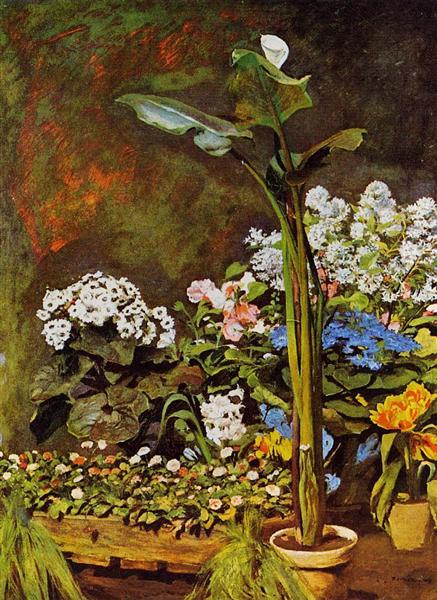Descriere
The painting "Arum and Greenhouse Plants" created by Pierre-Auguste Renoir in 1864 is a work that reflects both the artist's technical mastery and his intimate connection with nature. In this work, Renoir displays his mastery in the representation of light and color, defining characteristics of Impressionism and which would mark his career. Set in the context of a greenhouse, the painting delves into the study of flora, which becomes the undisputed protagonist of the canvas.
The composition of “Arum and Greenhouse Plants” is notable for its organic structure; the plants take centre stage, their graceful, sinuous forms contrasting with the rigidity of the architectural setting of the greenhouse. Renoir mixes different plant species, suggesting a rich biodiversity and a celebration of plant life. The choice of the arum, with its distinctive white flower and green envelope, stands out for its elegance and symbolism, evoking a sense of purity and harmony.
The use of colour in this work deserves special attention. Renoir employs a vibrant palette that oscillates between intense greens, bright whites and subtle shadows, creating a visual balance that invites the viewer to contemplate each nuance. The light filters delicately through the leaves, a phenomenon that the artist captures with ease, suggesting the natural irradiation that characterizes greenhouses. The atmosphere is enveloping and it seems that one can almost feel the humidity and fresh air of this protected space, where nature flourishes in safety.
Unlike other works by Renoir in which the human figure plays a predominant role, here the absence of characters highlights the naturalness of the plants. However, this choice does not detract from the depth of the work, but rather invites introspection about the connection between human beings and the natural environment. Plants are presented as silent witnesses of life, reminding us of the fragility and beauty that surrounds us.
While Arum and Greenhouse Plants is not as well known as some of the portraits or outdoor scenes Renoir painted in his later years, it is representative of his artistic curiosity and his evolution toward the Impressionist style. At this point in his career, Renoir was still grappling with the demands of realism and the praise of the everyday, which translates into his choice of a seemingly simple but nuanced subject.
In the broader context of Impressionism, Renoir shares affinities with other great masters of his time, such as Claude Monet and Camille Pissarro, who also explored light, color and atmosphere in their respective works. Each of them, however, brings a unique vision, and in Renoir's case, his approach to the depiction of plant life in Arum and Greenhouse Plants reveals a less-examined facet of his genius.
This painting is not only a testament to Renoir's technical talent, but also a reflection on how art can capture the essence of nature, a theme that would resonate strongly in Impressionism and continue to influence later generations of artists. In this sense, Arum and Greenhouse Plants stands as a milestone in the exploration of the relationship between art and nature, a legacy that remains relevant and invites a renewed appreciation of the beauty that flourishes in our environment.
KUADROS ©, a famous painting on your wall.
Hand-made oil painting reproductions, with the quality of professional artists and the distinctive seal of KUADROS ©.
Painting reproduction service with satisfaction guarantee. If you are not completely satisfied with the replica of your painting, we will refund 100% of your money.

